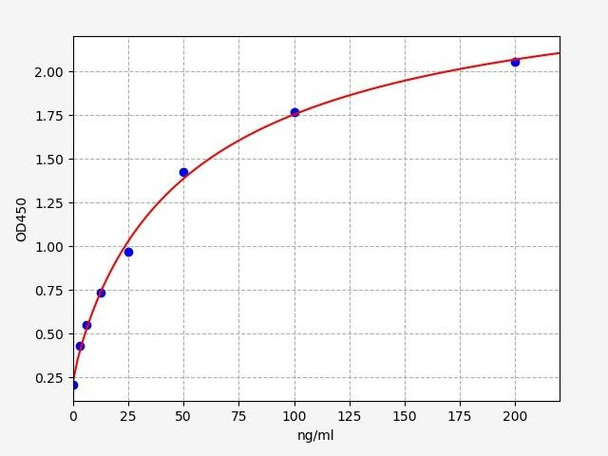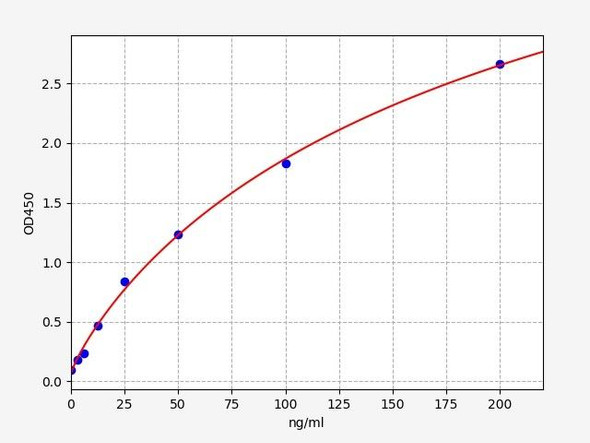Description
Mouse F12 (Coagulation Factor XII) ELISA Kit
The Mouse F12 (Coagulation Factor XII) ELISA Kit is specially designed for the precise measurement of coagulation factor XII levels in mouse serum, plasma, and cell culture supernatants. This ELISA kit offers exceptional sensitivity and specificity, ensuring accurate and consistent results for a variety of research needs.Coagulation factor XII is an essential protein involved in the coagulation cascade, playing a crucial role in blood clot formation. Dysregulation of factor XII has been linked to various coagulation disorders and cardiovascular diseases, making it a valuable biomarker for studying these conditions and exploring therapeutic interventions.
With its reliable performance and versatility, the Mouse F12 ELISA Kit is a valuable tool for researchers studying coagulation disorders, thrombosis, and cardiovascular diseases in mouse models. Get reliable and reproducible results with this high-quality ELISA kit from Assay Genie.
| Product Name: | Mouse F12 (Coagulation Factor XII) ELISA Kit |
| Product Code: | MOFI00826 |
| Size: | 96 Assays |
| Alias: | FXII, F12, F12, Coagulation factor XII, HAEX, Hageman factor, HAE3, HAF |
| Detection Method: | Sandwich ELISA |
| Application: | This immunoassay kit allows for the in vitro quantitative determination of Mouse FXIIIIII concentrations in serum plasma and other biological fluids. |
| Sensitivity: | 1.875ng/ml |
| Range: | 3.125-200ng/ml |
| Storage: | 4°C for 6 months |
| Note: | For Research Use Only |
| Recovery: | Matrices listed below were spiked with certain level of Mouse FXIIIIII and the recovery rates were calculated by comparing the measured value to the expected amount of Mouse FXIIIIII in samples. | ||||||||||||||||
| |||||||||||||||||
| Linearity: | The linearity of the kit was assayed by testing samples spiked with appropriate concentration of Mouse FXIIIIII and their serial dilutions. The results were demonstrated by the percentage of calculated concentration to the expected. | ||||||||||||||||
| |||||||||||||||||
| Intra Assay: | CV <8% | ||||||||||||||||
| Inter Assay: | CV <10% |
| Component | Quantity | Storage |
| ELISA Microplate (Dismountable) | 8×12 strips | 4°C for 6 months |
| Lyophilized Standard | 2 | 4°C/-20°C |
| Sample/Standard Dilution Buffer | 20ml | 4°C |
| Biotin-labeled Antibody(Concentrated) | 120ul | 4°C (Protect from light) |
| Antibody Dilution Buffer | 10ml | 4°C |
| HRP-Streptavidin Conjugate(SABC) | 120ul | 4°C (Protect from light) |
| SABC Dilution Buffer | 10ml | 4°C |
| TMB Substrate | 10ml | 4°C (Protect from light) |
| Stop Solution | 10ml | 4°C |
| Wash Buffer(25X) | 30ml | 4°C |
| Plate Sealer | 5 | - |
Other materials and equipment required:
- Microplate reader with 450 nm wavelength filter
- Multichannel Pipette, Pipette, microcentrifuge tubes and disposable pipette tips
- Incubator
- Deionized or distilled water
- Absorbent paper
- Buffer resevoir
| Uniprot | Q80YC5 |
| UniProt Protein Function: | F12: Factor XII is a serum glycoprotein that participates in the initiation of blood coagulation, fibrinolysis, and the generation of bradykinin and angiotensin. Prekallikrein is cleaved by factor XII to form kallikrein, which then cleaves factor XII first to alpha-factor XIIa and then trypsin cleaves it to beta- factor XIIa. Alpha-factor XIIa activates factor XI to factor XIa. Defects in F12 are the cause of factor XII deficiency (FA12D); also known as Hageman factor deficiency. This trait is an asymptomatic anomaly of in vitro blood coagulation. Its diagnosis is based on finding a low plasma activity of the factor in coagulating assays. It is usually only accidentally discovered through pre-operative blood tests. F12 deficiency is divided into two categories, a cross-reacting material (CRM)-negative group (negative F12 antigen detection) and a CRM-positive group (positive F12 antigen detection). Defects in F12 are the cause of hereditary angioedema type 3 (HAE3); also known as estrogen-related HAE or hereditary angioneurotic edema with normal C1 inhibitor concentration and function. HAE is characterized by episodic local subcutaneous edema, and submucosal edema involving the upper respiratory and gastrointestinal tracts. HAE3 occurs exclusively in women and is precipitated or worsened by high estrogen levels (e.g. during pregnancy or treatment with oral contraceptives). It differs from HAE types 1 and 2 in that both concentration and function of C1 inhibitor are normal. Belongs to the peptidase S1 family. |
| UniProt Protein Details: | Protein type:Protease; Secreted; Chaperone; EC 3.4.21.38; Secreted, signal peptide Cellular Component: extracellular space; extracellular region Molecular Function:peptidase activity; hydrolase activity; serine-type peptidase activity; serine-type endopeptidase activity; catalytic activity Biological Process: response to misfolded protein; positive regulation of blood coagulation; proteolysis; protein autoprocessing; fibrinolysis; hemostasis; plasma kallikrein-kinin cascade; regulation of blood coagulation; positive regulation of fibrinolysis; zymogen activation; protein processing; blood coagulation; Factor XII activation |
| NCBI Summary: | This gene encodes a glycoprotein coagulation factor that plays an important role in the intrinsic pathway of blood coagulation and hemostasis. The encoded protein is an inactive zymogen that is autoactivated upon contact with negatively charged surfaces or misfolded protein aggregates. Mice lacking the encoded protein have a severe defect in forming stable fibrin clots. [provided by RefSeq, Apr 2015] |
| UniProt Code: | Q80YC5 |
| NCBI GenInfo Identifier: | 171906584 |
| NCBI Gene ID: | 58992 |
| NCBI Accession: | NP_067464.2 |
| UniProt Secondary Accession: | Q80YC5,O35727, Q6PER0, |
| UniProt Related Accession: | Q80YC5 |
| Molecular Weight: | 75,000 (Approximate) |
| NCBI Full Name: | coagulation factor XII |
| NCBI Synonym Full Names: | coagulation factor XII (Hageman factor) |
| NCBI Official Symbol: | F12 |
| NCBI Official Synonym Symbols: | HAF; FXII |
| NCBI Protein Information: | coagulation factor XII; hageman factor |
| UniProt Protein Name: | Coagulation factor XII |
| UniProt Synonym Protein Names: | Hageman factor |
| Protein Family: | Coagulation factor |
| UniProt Gene Name: | F12 |
| UniProt Entry Name: | FA12_MOUSE |
*Note: Protocols are specific to each batch/lot. For the correct instructions please follow the protocol included in your kit.
| Step | Procedure |
| 1. | Set standard, test sample and control (zero) wells on the pre-coated plate respectively, and then, record their positions. It is recommended to measure each standard and sample in duplicate. Wash plate 2 times before adding standard, sample and control (zero) wells! |
| 2. | Aliquot 0.1ml standard solutions into the standard wells. |
| 3. | Add 0.1 ml of Sample / Standard dilution buffer into the control (zero) well. |
| 4. | Add 0.1 ml of properly diluted sample (Human serum, plasma, tissue homogenates and other biological fluids.) into test sample wells. |
| 5. | Seal the plate with a cover and incubate at 37 °C for 90 min. |
| 6. | Remove the cover and discard the plate content, clap the plate on the absorbent filter papers or other absorbent material. Do NOT let the wells completely dry at any time. Wash plate X2. |
| 7. | Add 0.1 ml of Biotin- detection antibody working solution into the above wells (standard, test sample & zero wells). Add the solution at the bottom of each well without touching the side wall. |
| 8. | Seal the plate with a cover and incubate at 37°C for 60 min. |
| 9. | Remove the cover, and wash plate 3 times with Wash buffer. Let wash buffer rest in wells for 1 min between each wash. |
| 10. | Add 0.1 ml of SABC working solution into each well, cover the plate and incubate at 37°C for 30 min. |
| 11. | Remove the cover and wash plate 5 times with Wash buffer, and each time let the wash buffer stay in the wells for 1-2 min. |
| 12. | Add 90 µL of TMB substrate into each well, cover the plate and incubate at 37°C in dark within 10-20 min. (Note: This incubation time is for reference use only, the optimal time should be determined by end user.) And the shades of blue can be seen in the first 3-4 wells (with most concentrated standard solutions), the other wells show no obvious color. |
| 13. | Add 50 µL of Stop solution into each well and mix thoroughly. The color changes into yellow immediately. |
| 14. | Read the O.D. absorbance at 450 nm in a microplate reader immediately after adding the stop solution. |
When carrying out an ELISA assay it is important to prepare your samples in order to achieve the best possible results. Below we have a list of procedures for the preparation of samples for different sample types.
| Sample Type | Protocol |
| Serum: | If using serum separator tubes, allow samples to clot for 30 minutes at room temperature. Centrifuge for 10 minutes at 1,000x g. Collect the serum fraction and assay promptly or aliquot and store the samples at -80°C. Avoid multiple freeze-thaw cycles. If serum separator tubes are not being used, allow samples to clot overnight at 2-8°C. Centrifuge for 10 minutes at 1,000x g. Remove serum and assay promptly or aliquot and store the samples at -80°C. Avoid multiple freeze-thaw cycles. |
| Plasma: | Collect plasma using EDTA or heparin as an anticoagulant. Centrifuge samples at 4°C for 15 mins at 1000 × g within 30 mins of collection. Collect the plasma fraction and assay promptly or aliquot and store the samples at -80°C. Avoid multiple freeze-thaw cycles. Note: Over haemolysed samples are not suitable for use with this kit. |
| Urine & Cerebrospinal Fluid: | Collect the urine (mid-stream) in a sterile container, centrifuge for 20 mins at 2000-3000 rpm. Remove supernatant and assay immediately. If any precipitation is detected, repeat the centrifugation step. A similar protocol can be used for cerebrospinal fluid. |
| Cell culture supernatant: | Collect the cell culture media by pipette, followed by centrifugation at 4°C for 20 mins at 1500 rpm. Collect the clear supernatant and assay immediately. |
| Cell lysates: | Solubilize cells in lysis buffer and allow to sit on ice for 30 minutes. Centrifuge tubes at 14,000 x g for 5 minutes to remove insoluble material. Aliquot the supernatant into a new tube and discard the remaining whole cell extract. Quantify total protein concentration using a total protein assay. Assay immediately or aliquot and store at ≤ -20°C. |
| Tissue homogenates: | The preparation of tissue homogenates will vary depending upon tissue type. Rinse tissue with 1X PBS to remove excess blood & homogenize in 20ml of 1X PBS (including protease inhibitors) and store overnight at ≤ -20°C. Two freeze-thaw cycles are required to break the cell membranes. To further disrupt the cell membranes you can sonicate the samples. Centrifuge homogenates for 5 mins at 5000xg. Remove the supernatant and assay immediately or aliquot and store at -20°C or -80°C. |
| Tissue lysates: | Rinse tissue with PBS, cut into 1-2 mm pieces, and homogenize with a tissue homogenizer in PBS. Add an equal volume of RIPA buffer containing protease inhibitors and lyse tissues at room temperature for 30 minutes with gentle agitation. Centrifuge to remove debris. Quantify total protein concentration using a total protein assay. Assay immediately or aliquot and store at ≤ -20 °C. |
| Breast Milk: | Collect milk samples and centrifuge at 10,000 x g for 60 min at 4°C. Aliquot the supernatant and assay. For long term use, store samples at -80°C. Minimize freeze/thaw cycles. |






